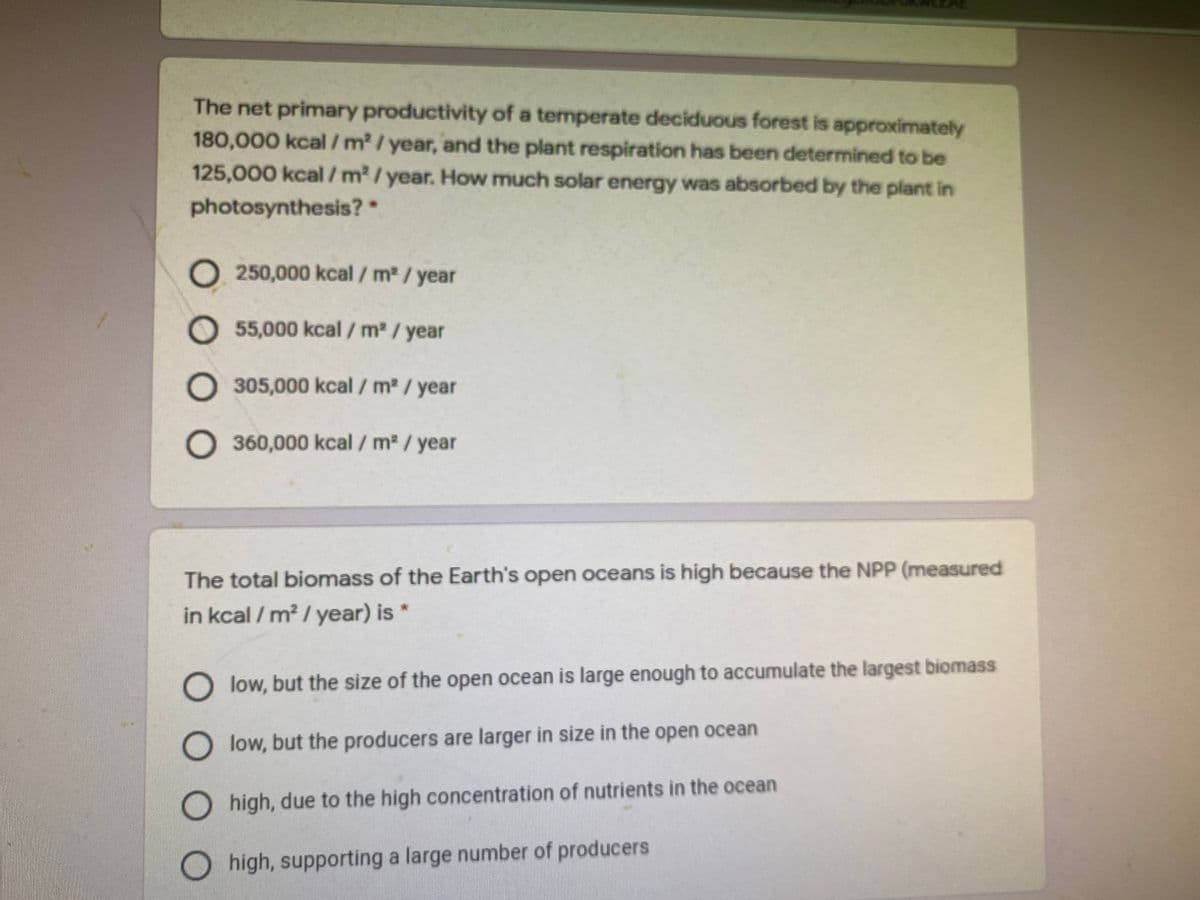The net primary productivity of a temperate deciduous forest is approximately 180,000 kcal /m2 / year, and the plant respiration has been determined to be 125,000 kcal/m²/year. How much solar energy was absorbed by the plant in photosynthesis? O. 250,000 kcal / m2/year O 55,000 kcal/ m / year 305,000 kcal /m /year O 360,000 kcal / m2 / year The total biomass of the Earth's open oceans is high because the NPP (measured in kcal / m2 / year) is * low, but the size of the open ocean is large enough to accumulate the largest biomass O low, but the producers are larger in size in the open ocean high, due to the high concentration of nutrients in the ocean O high, supporting a large number of producers
The net primary productivity of a temperate deciduous forest is approximately 180,000 kcal /m2 / year, and the plant respiration has been determined to be 125,000 kcal/m²/year. How much solar energy was absorbed by the plant in photosynthesis? O. 250,000 kcal / m2/year O 55,000 kcal/ m / year 305,000 kcal /m /year O 360,000 kcal / m2 / year The total biomass of the Earth's open oceans is high because the NPP (measured in kcal / m2 / year) is * low, but the size of the open ocean is large enough to accumulate the largest biomass O low, but the producers are larger in size in the open ocean high, due to the high concentration of nutrients in the ocean O high, supporting a large number of producers
Human Biology (MindTap Course List)
11th Edition
ISBN:9781305112100
Author:Cecie Starr, Beverly McMillan
Publisher:Cecie Starr, Beverly McMillan
Chapter24: Principles Of Ecology
Section: Chapter Questions
Problem 6SQ
Related questions
Question
I need help with the two questions attached below

Transcribed Image Text:The net primary productivity of a temperate deciduous forest is approximately
180,000 kcal/m/ year, and the plant respiration has been determined to be
125,000 kcal/ m2/year. How much solar energy was absorbed by the plant in
photosynthesis?*
O 250,000 kcal / m2 /year
O 55,000 kcal / m2 / year
305,000 kcal / m2 / year
O360,000 kcal / m2 / year
The total biomass of the Earth's open oceans is high because the NPP (measured
in kcal / m² / year) is *
O low, but the size of the open ocean is large enough to accumulate the largest biomass
O low, but the producers are larger in size in the open ocean
high, due to the high concentration of nutrients in the ocean
O high, supporting a large number of producers
Expert Solution
This question has been solved!
Explore an expertly crafted, step-by-step solution for a thorough understanding of key concepts.
This is a popular solution!
Trending now
This is a popular solution!
Step by step
Solved in 3 steps

Recommended textbooks for you

Human Biology (MindTap Course List)
Biology
ISBN:
9781305112100
Author:
Cecie Starr, Beverly McMillan
Publisher:
Cengage Learning

Biology 2e
Biology
ISBN:
9781947172517
Author:
Matthew Douglas, Jung Choi, Mary Ann Clark
Publisher:
OpenStax

Biology Today and Tomorrow without Physiology (Mi…
Biology
ISBN:
9781305117396
Author:
Cecie Starr, Christine Evers, Lisa Starr
Publisher:
Cengage Learning

Human Biology (MindTap Course List)
Biology
ISBN:
9781305112100
Author:
Cecie Starr, Beverly McMillan
Publisher:
Cengage Learning

Biology 2e
Biology
ISBN:
9781947172517
Author:
Matthew Douglas, Jung Choi, Mary Ann Clark
Publisher:
OpenStax

Biology Today and Tomorrow without Physiology (Mi…
Biology
ISBN:
9781305117396
Author:
Cecie Starr, Christine Evers, Lisa Starr
Publisher:
Cengage Learning